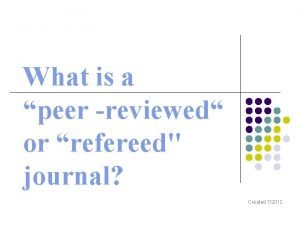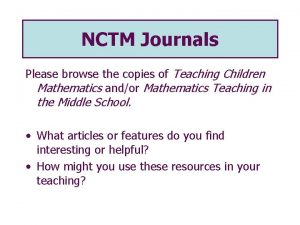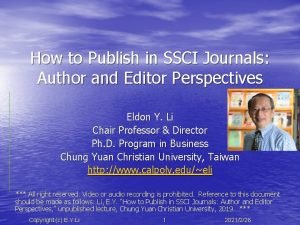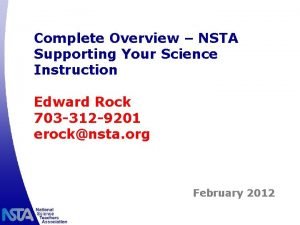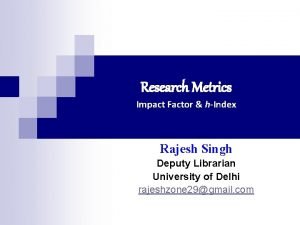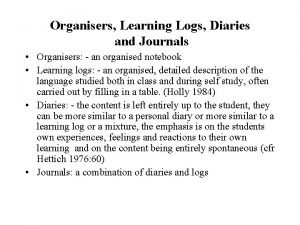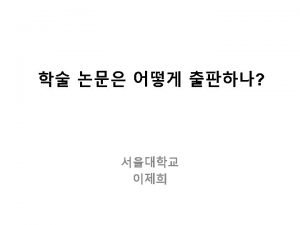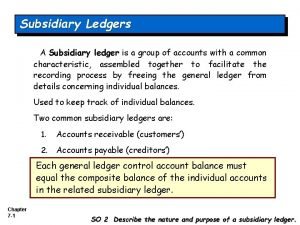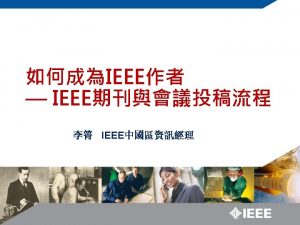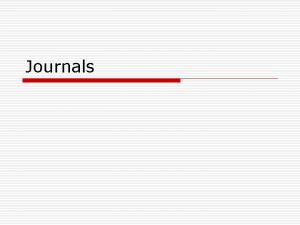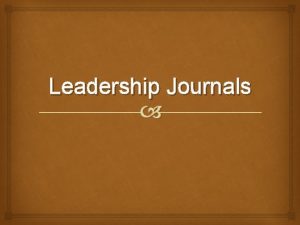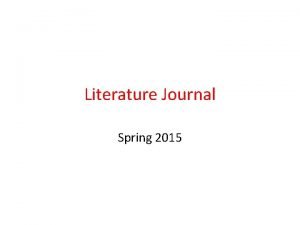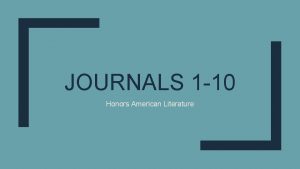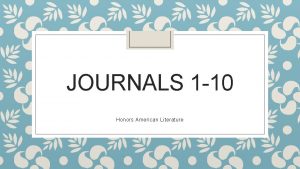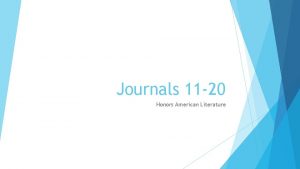Journals 31 40 10 th World Literature Journal












- Slides: 12

Journals 31 -40 10 th World Literature

Journal #31: Tell me a scary story…

Journal #32: Diction Copy and annotate: Most men wear their belts low here, there being so many outstanding bellies, some big enough to have names of their own and be formally introduced. Those men don’t suck them in or hide them in loose shirts; they let them hang free, they pat them, they stroke them as they stand around and talk. Answer: 1. What is the usual meaning of outstanding? What is its meaning here? What does this pun reveal about the attitude of the author toward his subject? 2. Read the second sentence again. How would the level of formality change is we changed suck to pull and let them hang free to accept them? Apply: Write a sentence or two describing an unattractive but beloved relative/friend. In your description, use words that describe the unattractive features honestly yet reveal that you care about that person, that you accept and even admire him/her, complete with defects. Use the example as a model.

Journal #33: Illusion vs. Reality Define: Illusion Define: Reality Explain the photo and how it relates to the idea of illusion versus reality.

Journal #34 Copy: I slowed still more, my shadow pacing me, dragging its head through the weeds that his the fence. –William Faulkner, The Sound and the Fury Answer: 1. In this sentence, form imitates meaning. How does Faulkner slow the sentence down, reinforcing the sentence’s meaning? 2. How would the impact of the sentence change if we rewrote the sentence to read: I slowed still more. My shadow paced me and dragged its head through the weedobscured fence. Apply: Using Faulkner's sentence as a model, write a sentence that expresses reluctance. Use at least two phrases and one clause to reinforce the meaning of your sentence.

Journal #35: Copy and annotate: The reason death sticks so closely to life isn’t biological necessity—its envy. Life is so beautiful that death has fallen in love with it, a jealous, possessive love that grabs at what it can. But life leaps over oblivion lightly, losing only a thing or two of no importance, and gloom is but the passing shadow of a cloud. –Pi Patel, Life of Pi Answer: 1. Explain the metaphor. 2. What effect does sentence length have on this passage? Apply: Compare an abstract idea to something else (freedom, love, hate, etc. ). First, write your comparison using only short, simple sentences. Then, re-write it using conjunctions and dependent clauses. What affect do these 2 styles have on your sentences?

Life of Pi: Chapters 1 -8 “Man is the most dangerous animal. ” Do you agree/disagree? Why/why not? “I know zoos are no longer in people’s good graces. Religion faces the same problem. Certain illusions about freedom plague them both. ” Explain what you think this line means. Also, do you agree/disagree? Why/why not?

Journal #36 Read and consider (DO NOT COPY): Wind rocks the car. We sit parked by the river, silence between our teeth. Birds scatter across islands of broken ice… Answer: 1. What are the feelings produced by the word rocks? Are the feelings gentle, violent or both? Explain. 2. Brainstorm other words to use in place of rocks that change the tone/meaning of the line. Choose 1 of those words an explain how it changes the tone/meaning. Apply: Narrative writing. Write a poem about the ‘we’ that is sitting in this car by the river, silent. Why are they there? Why are they silent? Write what happens before this stanza and what happens after. Please incorporate this stanza within your own poem.

Journal #37 1. Compare and contrast the 2 articles (Source A and Source B) that you have read for the Zoo synthesis writing on Monday. List 2 things they have in common and 2 things that are different. 2. After, answer the following: Which article did you like better and why? Source C Introduction: https: //www. youtube. com/watch? v=G 93 bei. Yi. E 74

Journal #38 Copy: All the hedges are singing with yellow birds! A boy runs by with lemons in his hands. Answer: 1. How does the image of the boy in the second line intensify your understanding of the hedges in the first line? 2. How would the effect be different if the second line read, “A boy runs with apples in his hands”? Apply: Write a sentence that conveys a feeling of extreme exuberance through the image of someone walking and carrying an object. Use only images, no figurative language.

Journal #39 Copy: The seven year’s difference in our ages lay between us like a chasm: I wondered if these years would ever operate between us as a bridge. Answer: 1. What function does the colon serve in the sentence? 2. What figurative language device is used to discuss the difference in their ages? 3. How would the meaning and impact of the sentence change if the sentence read as follows: The seven years’ difference in our ages lay between us like a chasm, and I wondered if these years would ever operate between us as abridge. Apply: Write two independent clauses; join the two with a colon, giving emphasis to the independent clause which follows the colon. Use the example as a model.

Journal #40 As requested, draw a pretty picture. HOWEVER, your picture must relate to some element of the SECOND part of Life of Pi
 What is a refereed journal
What is a refereed journal Nctm articles
Nctm articles Importance of cash journal
Importance of cash journal How to publish in ssci journals
How to publish in ssci journals Nsta journals
Nsta journals Ios press
Ios press How to identify fake journals
How to identify fake journals Bmj
Bmj Impact factor of journals
Impact factor of journals Examples of learning logs and journals
Examples of learning logs and journals Ieee transactions journals
Ieee transactions journals Advantages of subsidiary ledger
Advantages of subsidiary ledger Payables ledger control account
Payables ledger control account
